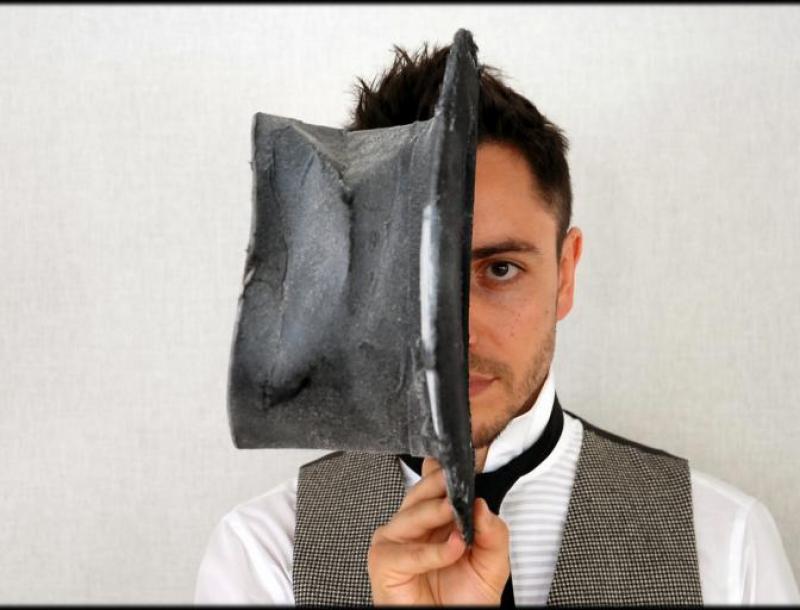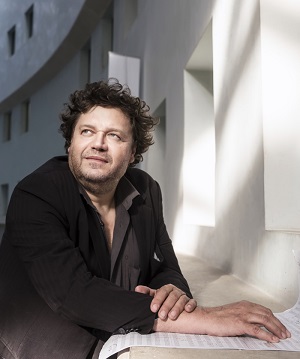Ensemble InterContemporain, Wigmore Hall | reviews, news & interviews
Ensemble InterContemporain, Wigmore Hall
Ensemble InterContemporain, Wigmore Hall
Eccentricity inspires colour, nuance and slapstick from young composer Matteo Franceschini

The Paris-based Ensemble InterContemporain brought a wide-ranging programme to the Wigmore Hall.
Most of the programme was made up of solo or piano-accompanied works, one each for clarinet, viola, violin, and two for flute. Among the soloists, the woodwind sounded more secure than the strings, with clarinettist Jérôme Comte and flautist Sophie Cherrier given many moments to shine. But the unsung hero was pianist Hidéki Nagano, a key ingredient in the programme’s continuity. Nagano has a fluid but definite touch and is able to draw an unusually elegant and warm tone from the Wigmore Steinway. That was immediately evident from the opening notes of the Debussy Première rapsodie, presented here by Nagano and Comte as an essay in colour and atmosphere. Comte began strongly, and although he lost some of his colour when the pace of the runs increased, he was always able to fall back on Nagano.
The Ravel Violin Sonata (now known as No. 2, the programme note reminded us) also benefitted from warm, lyrical accompaniment, but violinist Jeanne-Marie Conquer didn’t have the same presence. She was insecure in the opening and through much of the finale, and the Blues middle movement lacked the necessary swagger. Similarly, violist Odile Auboin was unconvincing in Maderna’s unaccompanied Viola, an open-form work that needs more conviction if it is not to sound merely arbitrary. No such problems, though, from Sophie Cherrier, whose Le Merle noir of Messiaen was the highlight of the first half, the blackbird here roused to colourful and varied song. Her rendition of Berio’s Sequenza I opened the second half, another agile and focused reading – or performance rather, as she played from memory.
 The two modern works were presented as culminations to each half of the concert. Schoeller’s Madrigal is for piano quartet, but neither its instrumentation nor its style give much of a clue as to the choice of title. The composer (pictured left by Franck Ferville) gave a cryptic allusion to the Renaissance vocal form in the programme, saying that his music, like that of the madrigalists, follows "uncountable transformations and pathways that exist between joy and melancholy". That phrase captures the complex but introverted emotional terrain of this music, and also its subtle continuity. We hear complex but subdued tremolo and glissando textures, initially in isolated fragments but soon coalescing into what seem like interconnected movements. An impressive continuity ultimately emerges, but even then it almost seems accidental.
The two modern works were presented as culminations to each half of the concert. Schoeller’s Madrigal is for piano quartet, but neither its instrumentation nor its style give much of a clue as to the choice of title. The composer (pictured left by Franck Ferville) gave a cryptic allusion to the Renaissance vocal form in the programme, saying that his music, like that of the madrigalists, follows "uncountable transformations and pathways that exist between joy and melancholy". That phrase captures the complex but introverted emotional terrain of this music, and also its subtle continuity. We hear complex but subdued tremolo and glissando textures, initially in isolated fragments but soon coalescing into what seem like interconnected movements. An impressive continuity ultimately emerges, but even then it almost seems accidental.
Matteo Franceschini’s work closed the programme, a Wigmore Hall co-commission here receiving its UK premiere. The title is long: ‘Les Excentriques’ Traité physionomique à l’usage des curieux, but is fully justified by the music itself. Franceschini explains that the six substantial movements are portraits of unnamed eccentric characters he has known, exploring the idea of physiological eccentricity from a number of musical angles. The ensemble was made up of every player so far heard: piano quartet plus flute and clarinet, the woodwinds both playing three different sizes of instrument, and the ensemble now conducted – an absolute necessity and done with great skill – by Jens McManama.
Of the six movements, the first and last are fast, while the middle four are slower, though never sedate or laid back. Eccentricity takes the form of disjointed dances in the outer movements, melodic profiles always close to the surface, but the rhythmic foundation fluid and continually morphing from one format to another. Similar ideas are heard in inner movements, a tick-tock obbligato in the violin, for example, remaining steady while all else shifts beneath. The use of the instruments throughout the work is incredibly subtle, even when the results are surreal, even slapstick, and the performance brought out every detail and nuance. Franceschini is clearly a name to watch, and is well deserving of this ensemble’s exemplary advocacy.
rating
Share this article
The future of Arts Journalism
You can stop theartsdesk.com closing!
We urgently need financing to survive. Our fundraising drive has thus far raised £49,000 but we need to reach £100,000 or we will be forced to close. Please contribute here: https://gofund.me/c3f6033d
And if you can forward this information to anyone who might assist, we’d be grateful.

Subscribe to theartsdesk.com
Thank you for continuing to read our work on theartsdesk.com. For unlimited access to every article in its entirety, including our archive of more than 15,000 pieces, we're asking for £5 per month or £40 per year. We feel it's a very good deal, and hope you do too.
To take a subscription now simply click here.
And if you're looking for that extra gift for a friend or family member, why not treat them to a theartsdesk.com gift subscription?
more Classical music
 Hallé John Adams festival, Bridgewater Hall / RNCM, Manchester review - standing ovations for today's music
From 1980 to 2025 with the West Coast’s pied piper and his eager following
Hallé John Adams festival, Bridgewater Hall / RNCM, Manchester review - standing ovations for today's music
From 1980 to 2025 with the West Coast’s pied piper and his eager following
 Kaploukhii, Greenwich Chamber Orchestra, Cutts, St James's Piccadilly review - promising young pianist
A robust and assertive Beethoven concerto suggests a player to follow
Kaploukhii, Greenwich Chamber Orchestra, Cutts, St James's Piccadilly review - promising young pianist
A robust and assertive Beethoven concerto suggests a player to follow
 Robin Holloway: Music's Odyssey review - lessons in composition
Broad and idiosyncratic survey of classical music is insightful but slightly indigestible
Robin Holloway: Music's Odyssey review - lessons in composition
Broad and idiosyncratic survey of classical music is insightful but slightly indigestible
 Classical CDs: Wolf-pelts, clowns and social realism
British ballet scores, 19th century cello works and contemporary piano etudes
Classical CDs: Wolf-pelts, clowns and social realism
British ballet scores, 19th century cello works and contemporary piano etudes
 Bizet in 150th anniversary year: rich and rare French offerings from Palazzetto Bru Zane
Specialists in French romantic music unveil a treasure trove both live and on disc
Bizet in 150th anniversary year: rich and rare French offerings from Palazzetto Bru Zane
Specialists in French romantic music unveil a treasure trove both live and on disc
 Scottish Chamber Orchestra, Ibragimova, Queen’s Hall, Edinburgh review - rarities, novelties and drumrolls
A pity the SCO didn't pick a better showcase for a shining guest artist
Scottish Chamber Orchestra, Ibragimova, Queen’s Hall, Edinburgh review - rarities, novelties and drumrolls
A pity the SCO didn't pick a better showcase for a shining guest artist
 Kilsby, Parkes, Sinfonia of London, Wilson, Barbican review - string things zing and sing in expert hands
British masterpieces for strings plus other-worldly tenor and horn - and a muscular rarity
Kilsby, Parkes, Sinfonia of London, Wilson, Barbican review - string things zing and sing in expert hands
British masterpieces for strings plus other-worldly tenor and horn - and a muscular rarity
 From Historical to Hip-Hop, Classically Black Music Festival, Kings Place review - a cluster of impressive stars for the future
From quasi-Mozartian elegance to the gritty humour of a kitchen inspection
From Historical to Hip-Hop, Classically Black Music Festival, Kings Place review - a cluster of impressive stars for the future
From quasi-Mozartian elegance to the gritty humour of a kitchen inspection
 Shibe, LSO, Adès, Barbican review - gaudy and glorious new music alongside serene Sibelius
Adès’s passion makes persuasive case for the music he loves, both new and old
Shibe, LSO, Adès, Barbican review - gaudy and glorious new music alongside serene Sibelius
Adès’s passion makes persuasive case for the music he loves, both new and old
 Anja Mittermüller, Richard Fu, Wigmore Hall review - a glorious hall debut
The Austrian mezzo shines - at the age of 22
Anja Mittermüller, Richard Fu, Wigmore Hall review - a glorious hall debut
The Austrian mezzo shines - at the age of 22
 First Person: clarinettist Oliver Pashley on the new horizons of The Hermes Experiment's latest album
Compositions by members of this unusual quartet feature for the first time
First Person: clarinettist Oliver Pashley on the new horizons of The Hermes Experiment's latest album
Compositions by members of this unusual quartet feature for the first time

Add comment